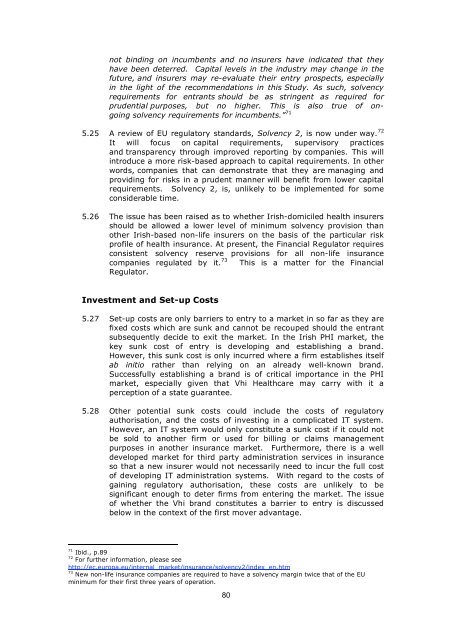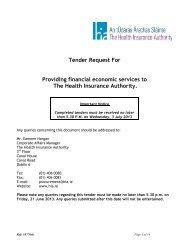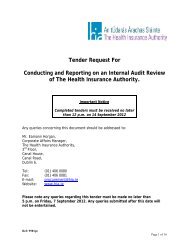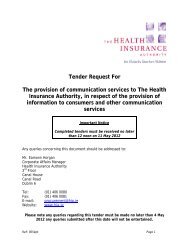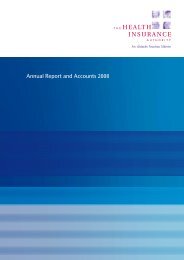Competition in the Irish Private Health Insurance Market
Competition in the Irish Private Health Insurance Market
Competition in the Irish Private Health Insurance Market
You also want an ePaper? Increase the reach of your titles
YUMPU automatically turns print PDFs into web optimized ePapers that Google loves.
not b<strong>in</strong>d<strong>in</strong>g on <strong>in</strong>cumbents and no <strong>in</strong>surers have <strong>in</strong>dicated that <strong>the</strong>y<br />
have been deterred. Capital levels <strong>in</strong> <strong>the</strong> <strong>in</strong>dustry may change <strong>in</strong> <strong>the</strong><br />
future, and <strong>in</strong>surers may re-evaluate <strong>the</strong>ir entry prospects, especially<br />
<strong>in</strong> <strong>the</strong> light of <strong>the</strong> recommendations <strong>in</strong> this Study. As such, solvency<br />
requirements for entrants should be as str<strong>in</strong>gent as required for<br />
prudential purposes, but no higher. This is also true of ongo<strong>in</strong>g<br />
solvency requirements for <strong>in</strong>cumbents.” 71<br />
5.25 A review of EU regulatory standards, Solvency 2, is now under way. 72<br />
It will focus on capital requirements, supervisory practices<br />
and transparency through improved report<strong>in</strong>g by companies. This will<br />
<strong>in</strong>troduce a more risk-based approach to capital requirements. In o<strong>the</strong>r<br />
words, companies that can demonstrate that <strong>the</strong>y are manag<strong>in</strong>g and<br />
provid<strong>in</strong>g for risks <strong>in</strong> a prudent manner will benefit from lower capital<br />
requirements. Solvency 2, is, unlikely to be implemented for some<br />
considerable time.<br />
5.26 The issue has been raised as to whe<strong>the</strong>r <strong>Irish</strong>-domiciled health <strong>in</strong>surers<br />
should be allowed a lower level of m<strong>in</strong>imum solvency provision than<br />
o<strong>the</strong>r <strong>Irish</strong>-based non-life <strong>in</strong>surers on <strong>the</strong> basis of <strong>the</strong> particular risk<br />
profile of health <strong>in</strong>surance. At present, <strong>the</strong> F<strong>in</strong>ancial Regulator requires<br />
consistent solvency reserve provisions for all non-life <strong>in</strong>surance<br />
companies regulated by it. 73 This is a matter for <strong>the</strong> F<strong>in</strong>ancial<br />
Regulator.<br />
Investment and Set-up Costs<br />
5.27 Set-up costs are only barriers to entry to a market <strong>in</strong> so far as <strong>the</strong>y are<br />
fixed costs which are sunk and cannot be recouped should <strong>the</strong> entrant<br />
subsequently decide to exit <strong>the</strong> market. In <strong>the</strong> <strong>Irish</strong> PHI market, <strong>the</strong><br />
key sunk cost of entry is develop<strong>in</strong>g and establish<strong>in</strong>g a brand.<br />
However, this sunk cost is only <strong>in</strong>curred where a firm establishes itself<br />
ab <strong>in</strong>itio ra<strong>the</strong>r than rely<strong>in</strong>g on an already well-known brand.<br />
Successfully establish<strong>in</strong>g a brand is of critical importance <strong>in</strong> <strong>the</strong> PHI<br />
market, especially given that Vhi <strong>Health</strong>care may carry with it a<br />
perception of a state guarantee.<br />
5.28 O<strong>the</strong>r potential sunk costs could <strong>in</strong>clude <strong>the</strong> costs of regulatory<br />
authorisation, and <strong>the</strong> costs of <strong>in</strong>vest<strong>in</strong>g <strong>in</strong> a complicated IT system.<br />
However, an IT system would only constitute a sunk cost if it could not<br />
be sold to ano<strong>the</strong>r firm or used for bill<strong>in</strong>g or claims management<br />
purposes <strong>in</strong> ano<strong>the</strong>r <strong>in</strong>surance market. Fur<strong>the</strong>rmore, <strong>the</strong>re is a well<br />
developed market for third party adm<strong>in</strong>istration services <strong>in</strong> <strong>in</strong>surance<br />
so that a new <strong>in</strong>surer would not necessarily need to <strong>in</strong>cur <strong>the</strong> full cost<br />
of develop<strong>in</strong>g IT adm<strong>in</strong>istration systems. With regard to <strong>the</strong> costs of<br />
ga<strong>in</strong><strong>in</strong>g regulatory authorisation, <strong>the</strong>se costs are unlikely to be<br />
significant enough to deter firms from enter<strong>in</strong>g <strong>the</strong> market. The issue<br />
of whe<strong>the</strong>r <strong>the</strong> Vhi brand constitutes a barrier to entry is discussed<br />
below <strong>in</strong> <strong>the</strong> context of <strong>the</strong> first mover advantage.<br />
71 Ibid., p.89<br />
72 For fur<strong>the</strong>r <strong>in</strong>formation, please see<br />
http://ec.europa.eu/<strong>in</strong>ternal_market/<strong>in</strong>surance/solvency2/<strong>in</strong>dex_en.htm<br />
73 New non-life <strong>in</strong>surance companies are required to have a solvency marg<strong>in</strong> twice that of <strong>the</strong> EU<br />
m<strong>in</strong>imum for <strong>the</strong>ir first three years of operation.<br />
80


